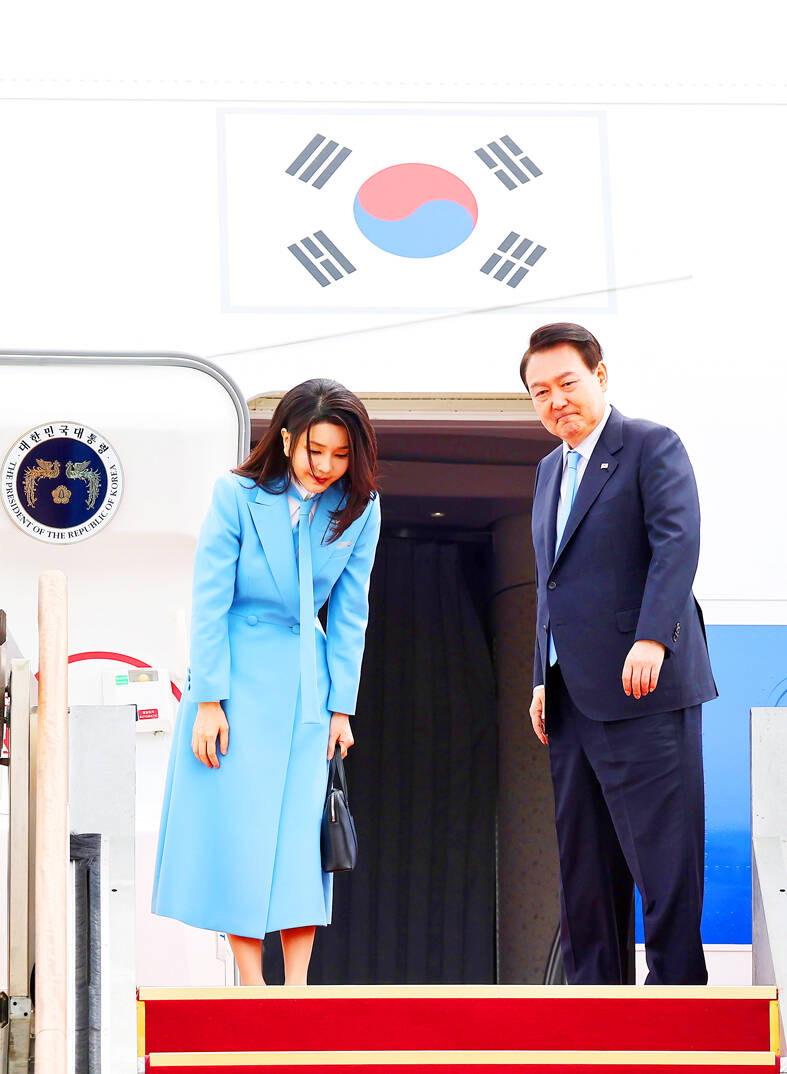South Korean President Yoon Suk-yeol yesterday flew to Washington for a six-day state visit, as the allies move to bulk up military cooperation over North Korea’s expanding nuclear threats.
Pyongyang has conducted another record-breaking string of sanctions-defying launches this year, including test-firing the country’s first solid-fuel ballistic missile this month — a key technical breakthrough for North Korean leader Kim Jong-un’s military.
In response, Yoon has pulled Seoul closer to long-standing ally Washington, and the trip has a packed schedule, including a summit with US President Joe Biden tomorrow, when the pair are to celebrate 70 years of ties.

Photo: EPA-EFE
“The two leaders will spend a lot of time together over the course of many events to celebrate the achievements of the South Korea-US alliance over 70 years, and exchange in-depth views on the alliance’s future,” South Korean Principal Deputy National Security Adviser Kim Tae-hyo said ahead of the trip.
However, analysts say that Yoon and Biden will have a lot to hash out at their summit.
Even though such events are “highly scripted,” the two leaders have some “uncomfortable” topics to discuss, said Katharine Moon, professor emerita of political science at Wellesley College.
The trip comes as Yoon grapples with the South’s increasingly nervous public about the US commitment to so-called extended deterrence, where US assets — including nuclear weapons — serve to prevent attacks on allies.
A majority of South Koreans believe the country should develop its own nuclear weapons, multiple surveys show.
Yoon has hinted that Seoul could pursue this option.
“There is a greater need for the United States to show its deterrence commitments at the alliance level,” said Park Won-gon, a professor of North Korean Studies at Ewha University in Seoul.
Yoon has seen his domestic approval ratings dive, hit hard by public disapproval over his handling of a recent US intelligence leak that appeared to reveal Washington was spying on Seoul.
The White House has said the visit showed how the “ironclad” alliance “has grown far beyond the Korean Peninsula, and is now a force for good in the Indo-Pacific and around the world.”
“The breadth and the depth of the relationship will be amply reinforced and showcased,” during the visit, US Department of State Deputy Assistant Secretary Jung Pak said.
Yoon is likely to come under pressure to do more to help the US support Ukraine, as Washington looks to South Korea — the world’s ninth-largest arms exporter — to help secure ammunition and weapons for Kyiv.
South Korea has sent humanitarian assistance to Ukraine, and has sold tanks and howitzers to Poland, but has a longstanding policy of not providing weapons to active conflict zones.
Seoul is also mired in a diplomatic spat with Beijing after Yoon blamed recent heightened tensions over Taiwan on “attempts to change the status quo by force” in an interview.

A fire caused by a burst gas pipe yesterday spread to several homes and sent a fireball soaring into the sky outside Malaysia’s largest city, injuring more than 100 people. The towering inferno near a gas station in Putra Heights outside Kuala Lumpur was visible for kilometers and lasted for several hours. It happened during a public holiday as Muslims, who are the majority in Malaysia, celebrate the second day of Eid al-Fitr. National oil company Petronas said the fire started at one of its gas pipelines at 8:10am and the affected pipeline was later isolated. Disaster management officials said shutting the

US Vice President J.D. Vance on Friday accused Denmark of not having done enough to protect Greenland, when he visited the strategically placed and resource-rich Danish territory coveted by US President Donald Trump. Vance made his comment during a trip to the Pituffik Space Base in northwestern Greenland, a visit viewed by Copenhagen and Nuuk as a provocation. “Our message to Denmark is very simple: You have not done a good job by the people of Greenland,” Vance told a news conference. “You have under-invested in the people of Greenland, and you have under-invested in the security architecture of this

Japan unveiled a plan on Thursday to evacuate around 120,000 residents and tourists from its southern islets near Taiwan within six days in the event of an “emergency”. The plan was put together as “the security situation surrounding our nation grows severe” and with an “emergency” in mind, the government’s crisis management office said. Exactly what that emergency might be was left unspecified in the plan but it envisages the evacuation of around 120,000 people in five Japanese islets close to Taiwan. China claims Taiwan as part of its territory and has stepped up military pressure in recent years, including

UNREST: The authorities in Turkey arrested 13 Turkish journalists in five days, deported a BBC correspondent and on Thursday arrested a reporter from Sweden Waving flags and chanting slogans, many hundreds of thousands of anti-government demonstrators on Saturday rallied in Istanbul, Turkey, in defence of democracy after the arrest of Istanbul Mayor Ekrem Imamoglu which sparked Turkey’s worst street unrest in more than a decade. Under a cloudless blue sky, vast crowds gathered in Maltepe on the Asian side of Turkey’s biggest city on the eve of the Eid al-Fitr celebration which started yesterday, marking the end of Ramadan. Ozgur Ozel, chairman of the main opposition Republican People’s Party (CHP), which organized the rally, said there were 2.2 million people in the crowd, but